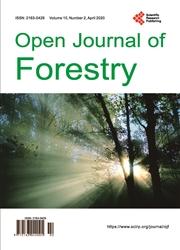The Impact of Governance Regime on Land Cover and Use Change and Forest Structure: Insights from Kakamega and Loita Forests, Kenya
引用次数: 0
Abstract
Forests in Kenya are managed under different management regimes, including traditional community based forest management, command and control, participatory forest management, leasehold, concessions, and private. Assessment of these regimes’ impact (positively or negatively) on forest conservation has not been done. The study was done to determine the impact on forest conservation of three management regimes traditional community based forest management, command and control, and participatory forest management. The survey was done through secondary data, focus group discussion, key informant interview, household survey, ecological survey, and land cover and land use analysis through GIS. The results indicate that the forest site under participatory forest management witnessed better forest management. In this site, the forest zone witnessing best management was the one near the forest station where the rangers are located and adjacent to the community that has been involved in forest management and benefited most from project intervention, an incentive for their participation in forest management. The forests under traditional community based forest management faced a high forest degradation rate. Forest under command and control regime witnessed the best forest condition improvement attributed to the management regime not allowing consumptive forest resource utilization. Each regime was best under its’ legislative framework and would facilitate better forest management and contribute to improved livelihoods without compromising forest quality. Participatory forest management was the most preferred management regime contributing to better forest management, improved community livelihoods, and formally involved communities and other stakeholders. Each regime’s appropriateness would be enhanced through stakeholder capacity building, institutional reform, adequate financial facilitation, and appropriate implementation. Therefore, adopting participatory forest management attributes to the other two management regimes would enhance their appropriateness, while appreciating that the management objective determines the regime being implemented in each forest.治理制度对土地覆盖和利用变化以及森林结构的影响:来自肯尼亚卡卡梅加和洛伊塔森林的见解
肯尼亚的森林在不同的管理制度下进行管理,包括传统的以社区为基础的森林管理、命令和控制、参与式森林管理、租赁、特许权和私人管理。尚未对这些制度对森林保护的影响(积极或消极)进行评估。这项研究是为了确定三种管理制度对森林保护的影响,即传统的以社区为基础的森林管理、命令和控制以及参与式森林管理。调查采用二次资料法、焦点小组讨论法、关键信息者访谈法、入户调查法、生态调查法、利用GIS进行土地覆盖和土地利用分析等方法。结果表明,参与式森林经营的立地森林经营效果较好。在这个地点,管理最好的森林区域是靠近护林员所在的森林站,并且毗邻参与森林管理并从项目干预中受益最多的社区,这是他们参与森林管理的一种激励。传统的以群落为基础的森林经营方式面临着森林退化率高的问题。在指挥管制制度下的森林,由于不允许消耗性森林资源利用的管理制度,森林状况改善最好。每一种制度在其立法框架下都是最好的,并将在不损害森林质量的情况下促进更好的森林管理和改善生计。参与式森林管理是最受欢迎的管理制度,有助于改善森林管理,改善社区生计,并使社区和其他利益攸关方正式参与。通过利益相关者能力建设、机构改革、充分的金融便利和适当的实施,每个机制的适当性都将得到加强。因此,采用其他两种管理制度的参与性森林管理特性将提高它们的适当性,同时认识到管理目标决定了在每一个森林执行的制度。
本文章由计算机程序翻译,如有差异,请以英文原文为准。
求助全文
约1分钟内获得全文
求助全文

 求助内容:
求助内容: 应助结果提醒方式:
应助结果提醒方式:


